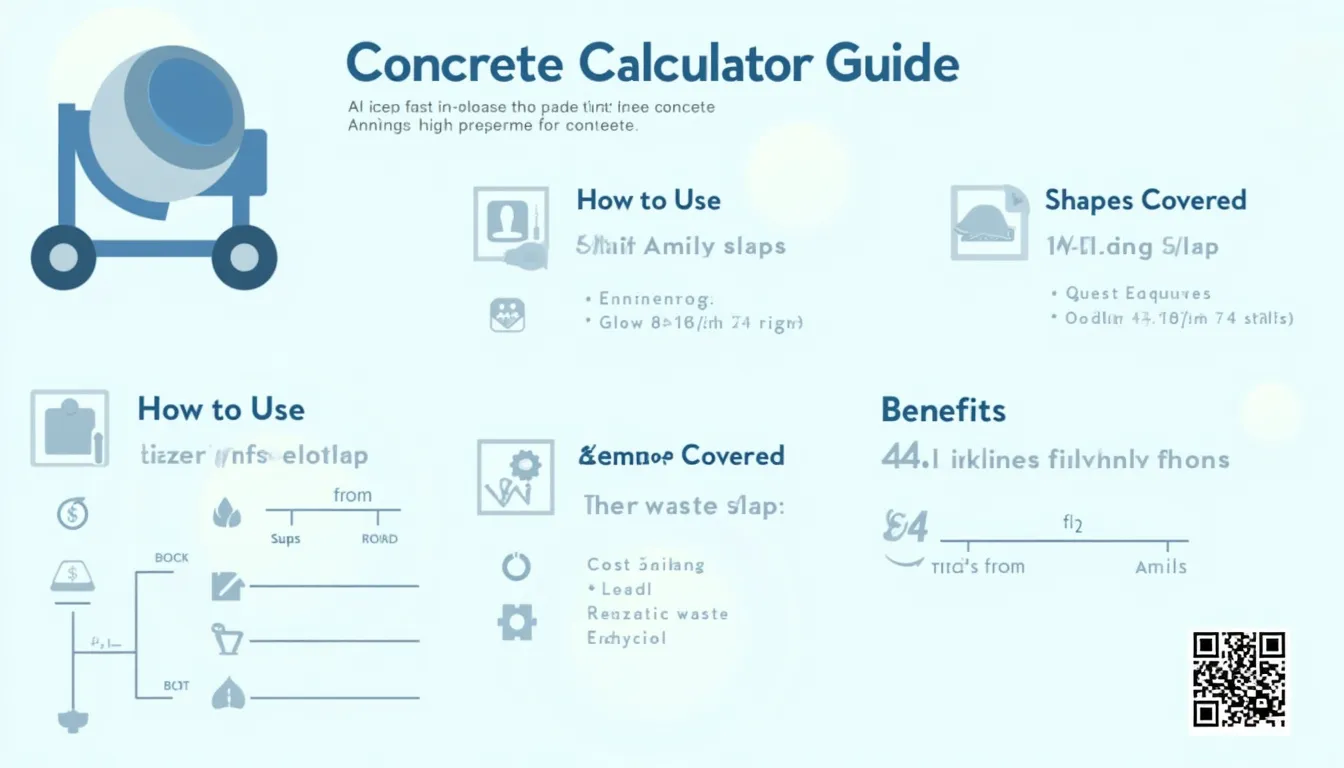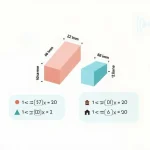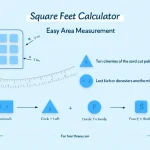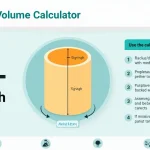Concrete Calculator
Is this tool helpful?
How to Use the Concrete Calculator Effectively
Our comprehensive Concrete Calculator is designed to help you accurately estimate the amount of concrete needed for various construction projects. Follow these steps to use the calculator effectively:
- Select the Shape: Choose the appropriate shape for your project from the dropdown menu. Options include:
- Slab
- Column (Rectangular)
- Column (Cylindrical)
- Footing
- Steps
- Choose Units: Select either Metric (meters) or Imperial (feet) units for your measurements.
- Enter Dimensions: Input the required dimensions based on your selected shape:
- Length: Enter the length of your structure (e.g., 5 meters or 16 feet)
- Width: Enter the width of your structure (e.g., 3 meters or 10 feet)
- Height/Thickness: Enter the height or thickness of your structure (e.g., 0.15 meters or 0.5 feet)
- Radius: For cylindrical columns, enter the radius (e.g., 0.3 meters or 1 foot)
- Number of Steps: For step calculations, enter the number of steps (e.g., 10)
- Waste Factor: Enter a waste factor percentage to account for spillage and variations. The default is set to 10%, but you can adjust this based on your project’s needs.
- Cost per Unit Volume: Optionally, enter the cost per unit volume of concrete to calculate the total cost of your project.
- Calculate: Click the “Calculate” button to generate your results.
The calculator will then display the following results:
- Calculated Volume: The basic volume of concrete required
- Total Required Volume: Volume including the waste factor
- Number of Concrete Bags Needed: Estimated number of 50kg bags required
- Total Estimated Cost: If you provided a cost per unit volume
Understanding Concrete Calculations: Your Key to Successful Construction Projects
Concrete is the foundation of modern construction, quite literally. Whether you’re a professional contractor, a DIY enthusiast, or a homeowner planning a renovation, accurately calculating the amount of concrete needed for your project is crucial. Our Concrete Calculator is designed to simplify this process, ensuring you order the right amount of concrete, save money, and complete your project efficiently.
The Importance of Precise Concrete Calculations
Estimating concrete volume might seem straightforward, but it’s a task that requires precision. Overestimating can lead to unnecessary expenses and wasted materials, while underestimating can cause project delays and additional costs. Our calculator takes into account various shapes and factors to provide you with the most accurate estimate possible.
Versatility in Construction
From simple slabs to complex cylindrical columns, our calculator covers a wide range of construction elements. Whether you’re pouring a foundation, building a retaining wall, or creating decorative steps, this tool has you covered.
Benefits of Using the Concrete Calculator
1. Cost Savings
By providing accurate estimates, the calculator helps you avoid overordering concrete, which can be a significant expense in any construction project. The inclusion of a waste factor also ensures you don’t underorder, preventing costly project delays.
2. Time Efficiency
Manual calculations can be time-consuming and prone to errors. Our calculator provides instant results, allowing you to focus on other aspects of your project planning.
3. Waste Reduction
Accurate ordering means less waste, which is not only cost-effective but also environmentally friendly. Concrete production has a significant carbon footprint, so minimizing waste contributes to sustainable construction practices.
4. Project Planning
Knowing the exact amount of concrete needed helps in better project planning. You can accurately schedule deliveries, arrange for the right size of mixing equipment, and plan your workforce accordingly.
5. Flexibility in Units
The option to switch between metric and imperial units makes this calculator versatile for users worldwide, eliminating the need for manual conversions.
Addressing User Needs: Precision in Every Pour
Our Concrete Calculator addresses several key user needs in the construction and DIY sectors:
Accuracy in Various Shapes
Construction projects often involve complex shapes. Our calculator provides formulas for different structures:
Rectangular Slab or Footing
$$V = L \times W \times H$$Where V is volume, L is length, W is width, and H is height or thickness.
Cylindrical Column
$$V = \pi r^2 h$$Where r is the radius and h is the height of the column.
Steps
$$V_{total} = n \times (L \times W \times H)$$Where n is the number of steps, and L, W, H are the dimensions of each step.
Example Calculation: Concrete Slab
Let’s say you’re pouring a concrete slab for a patio:
- Length: 6 meters
- Width: 4 meters
- Thickness: 0.1 meters
- Waste Factor: 10%
The calculator would perform the following steps:
- Calculate base volume: 6 m × 4 m × 0.1 m = 2.4 m³
- Apply waste factor: 2.4 m³ × 1.10 = 2.64 m³
- Calculate bags needed: 2.64 m³ ÷ 0.017 m³/bag ≈ 156 bags
This quick calculation helps you order the right amount of concrete, factoring in potential waste.
Practical Applications: From Foundation to Finish
The Concrete Calculator finds applications across various construction scenarios:
1. Residential Construction
- Foundations for new homes
- Driveways and patios
- Sidewalks and walkways
- Retaining walls
2. Commercial Projects
- Parking lots
- Building foundations
- Structural columns
- Floor slabs for multi-story buildings
3. Infrastructure Development
- Bridge supports
- Road construction
- Culverts and drainage systems
4. DIY and Home Improvement
- Garden paths
- Shed foundations
- Decorative concrete features
- Fence post footings
5. Agricultural Applications
- Barn floors
- Silage bunkers
- Irrigation channels
Advanced Features for Comprehensive Planning
Cost Estimation
By inputting the cost per unit volume, you can get an instant estimate of your project’s concrete expenses. This feature is invaluable for budgeting and comparing quotes from different suppliers.
Waste Factor Customization
While the default waste factor is set at 10%, you can adjust this based on your project’s specific needs. For complex shapes or challenging pour conditions, you might increase this to 15% or more.
Multiple Shape Options
The inclusion of various shapes like slabs, columns, and steps makes this calculator versatile for different construction needs. Each shape selection dynamically adjusts the input fields, ensuring you only enter relevant information.
Maximizing Efficiency in Concrete Projects
Planning for Optimal Pours
Using the calculator’s results, you can plan your concrete pours more effectively. For large projects, you might divide the total volume into manageable sections, ensuring each pour is completed before the concrete begins to set.
Coordinating with Suppliers
Armed with accurate volume calculations, you can communicate more effectively with concrete suppliers. This precision helps in scheduling deliveries and ensures you have the right amount of concrete when you need it.
Estimating Additional Materials
While the calculator focuses on concrete volume, you can use this information to estimate other necessary materials:
- Reinforcement: Calculate the amount of rebar or wire mesh needed
- Formwork: Estimate the square footage of forms required
- Finishing materials: Plan for sealants, colorants, or other surface treatments
Frequently Asked Questions (FAQ)
Q1: How accurate is the Concrete Calculator?
A1: The calculator provides highly accurate results based on the dimensions you input. However, real-world conditions can vary, which is why we include a waste factor option.
Q2: Can I use this calculator for ready-mix concrete orders?
A2: Absolutely! The volume calculations are suitable for both bagged concrete and ready-mix orders. For ready-mix, you’ll want to focus on the total required volume rather than the number of bags.
Q3: What if my project involves multiple shapes?
A3: For complex projects involving multiple shapes, calculate each component separately and sum the results. This approach ensures accuracy for each distinct part of your project.
Q4: How do I account for sloped surfaces?
A4: For sloped surfaces, calculate using the average depth. For example, if a slab slopes from 4 inches to 6 inches, use 5 inches as your height input.
Q5: Does the calculator account for reinforcement volume?
A5: The calculator provides the total concrete volume. While reinforcement does displace some concrete, its volume is typically negligible and falls within the waste factor allowance.
Q6: Can I save my calculations for future reference?
A6: Currently, the calculator doesn’t have a save feature. We recommend noting down your inputs and results for future reference or project documentation.
Q7: How does the waste factor work?
A7: The waste factor adds a percentage to your calculated volume to account for spillage, over-excavation, and other variables. A 10% waste factor means you’ll order 10% more concrete than the base calculation.
Q8: Is this calculator suitable for professional use?
A8: Yes, the calculator is designed to be useful for both professionals and DIY enthusiasts. However, for large-scale or complex commercial projects, it’s always advisable to consult with a structural engineer.
Conclusion: Building with Confidence
The Concrete Calculator is more than just a tool; it’s your partner in successful construction projects. By providing accurate volume estimates, cost projections, and material requirements, it empowers you to build with confidence. Whether you’re a seasoned contractor or a weekend warrior, this calculator ensures that your concrete projects are planned efficiently, executed smoothly, and completed without unnecessary waste or expense.
Remember, while this calculator is a powerful aid, it’s always important to consider local building codes, environmental factors, and specific project requirements. For complex or large-scale projects, consulting with a professional engineer or experienced contractor is always recommended.
With the Concrete Calculator at your fingertips, you’re well-equipped to tackle your next construction project, big or small. Happy building!
Important Disclaimer
The calculations, results, and content provided by our tools are not guaranteed to be accurate, complete, or reliable. Users are responsible for verifying and interpreting the results. Our content and tools may contain errors, biases, or inconsistencies. We reserve the right to save inputs and outputs from our tools for the purposes of error debugging, bias identification, and performance improvement. External companies providing AI models used in our tools may also save and process data in accordance with their own policies. By using our tools, you consent to this data collection and processing. We reserve the right to limit the usage of our tools based on current usability factors. By using our tools, you acknowledge that you have read, understood, and agreed to this disclaimer. You accept the inherent risks and limitations associated with the use of our tools and services.







